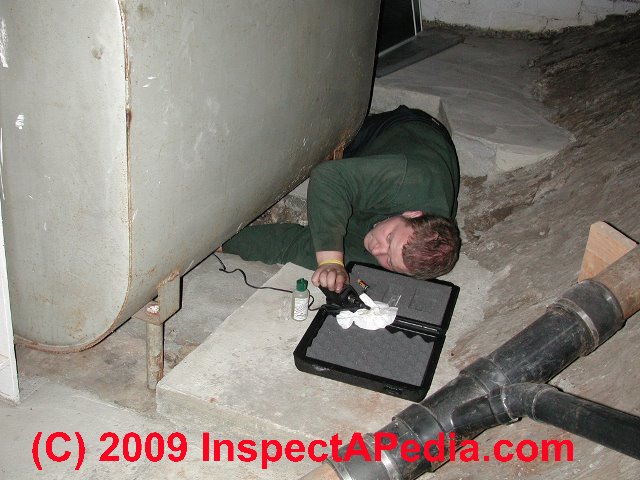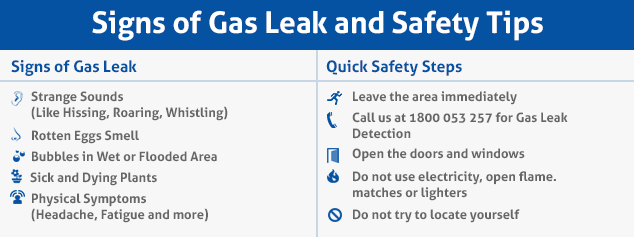Table of Content
Do not use sparks or anything that could generate or avoid the electric charge. For example, lighters, open flames, mechanical devices, rotary telephones, light switches, doorbells, thermostats, etc., from which flames or sparks can explode or ignite. The best way to detect the symptoms of leaking gas is to install a carbon monoxide detector near your bedroom at home. This device will make a loud noise and help to detect if there is carbon monoxide in the air.

To detect a gas leak, check your home for a rotten egg or sulfuric smell, especially around appliances like your stove or water heater. If the scent is strong, immediately turn off the gas supply line to your house, leave the building and get help. Otherwise, you can determine where the gas is leaking from by listening for a hissing or whistling noise near your appliances or pipes. In particular, you should check your gas stove, if you have one, to make sure that all of the burners are off.
Will a carbon monoxide detector detect a gas leak?
There are telltale signs and clear indications that present themselves, ranging from odors to health problems. Here are some ways to determine if you have a gas leak and some recommendations on what to do about it. First, you need to know about the possible causes of gas leaks and natural gas protection, then let your family members and even the children in the house know and learn.
Gas leaks are insidious and silent, and their results cannot always be detected immediately, especially not by human senses. When you factor in how dangerous these incidents can be to you and to your team, it becomes clear that a solid set of gas detection tools and methods is required. Turn on the gas, and check for leaks using a detector or your preferred detection method. Repeat the gas leak sealing process until you are sure there are no more gas leaks. If you need to locate the exact source of a gas leak, it's best to go with a portable gas detector like the Y201 Portable Propane and Natural Gas Leak Detector.
Rotten Egg Smell
If the stove is emitting orange or red flames after it’s been lit, it’s best to err on the side of precaution. If you smell a rotten egg or sulfur-like odor in or around your home, at work or in your neighborhood, this odor may be the result of a natural gas leak. Natural gas is colorless and odorless, so we’ve added an odorant called mercaptan to warn you of a natural gas leak.

While evacuating your residence, don’t touch any electrical devices. You want to avoid causing any sparks, and turning appliances on and off can produce these. If something is on, leave it on, and if something is off, leave it off. Not all toxic gases leak from appliances, vents, and pipes.
Using Gas Detectors
Once this has been done, proceed to check the gas meter; it should remain inactive if there’s nothing wrong. Another way to detect if your stove is leaking gas is to compare your gas bills over 2 – 3 months. If you notice an unusual spike in cost, there might be a gas leak.
Of all the tools available to you, it isgas detectorsthat are going to be the most useful, as well as the most reliable. In other words, you need to know the basics of checking for gas leaks in your home. Dip a small paintbrush into the soapy water so the bristles are completely coated. Paint a thin layer of the water around the pipe connections where you think there may be a leak.
Gas stoves should have blue flames, meaning that they have enough oxygen for the gas to completely combust. When there are yellow or orange flames, the natural gas isn’t completely burning and could be contributing to a gas leak. Set a radon detection test in the lowest level of your home. Radon is a natural gas that’s odorless, colorless, and tasteless naturally found in the ground. Place a short-term test kit in the lowest level of your home where people spend time and leave it there for 90 days. Use the envelope provided in the kit to send the test to a lab where they can calculate the radon levels.
The soap can be put in a spray bottle or placed in a bowl for sponging on. Dish washing soap is formulated to make lots of bubbles so it works better for the soap test for gas leak. In this very simple test, you just coat all of the gas transmission gear (pipes, hoses, valves, etc.) with soapy water and then pressurise the system. Next, open the windows and ensure all occupants make their way out of the home immediately. Once you’re at a safe distance from the home, call your gas company and don’t reenter the house until a professional deems it safe.
If you get a hissing sound with a smile or feel the situation is out of control, leave the area immediately! If you smell propane inside or outside the house, take yourself and your family out of the house as soon as possible without trying to solve the problem. In many types of industry, chlorine gas leaks are a serious danger. If your premises deals with this type of gas, you need to be prepared.

In addition to the health risks, gas leaks carry explosive potential due to the highly flammable nature of the vapors. For half the country, natural gas is the way we heat our homes, cook food, heat water, and dry our clothing. While usually safe, there are circumstances where natural gas can become dangerous.
The valve might only be loose, and a tightening might solve your problem. If your water heater is electric, you can also check your home's circuit breaker box. The breaker dedicated to your water heater might have tripped. Turn your heater off, wait two to five minutes, then turn it back on. ♦ Soap bubbles will form if there is a gas leak and you may also smell the gas. Contrary to what you might think, you’ll conduct this test through a plumber rather than an electric or energy company.


No comments:
Post a Comment